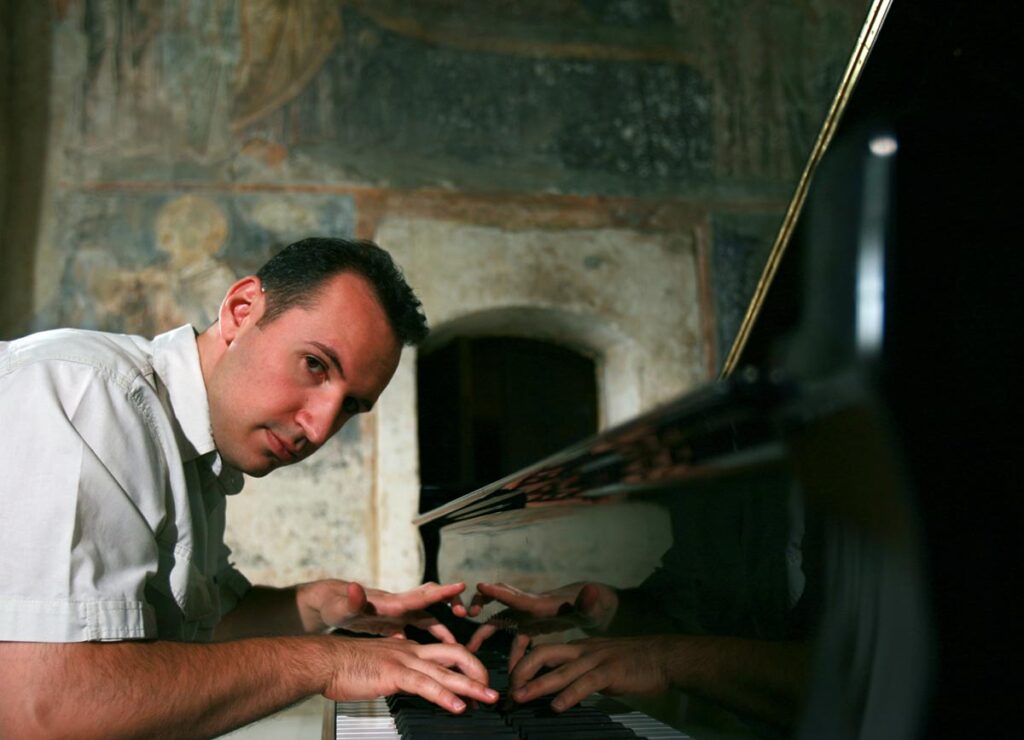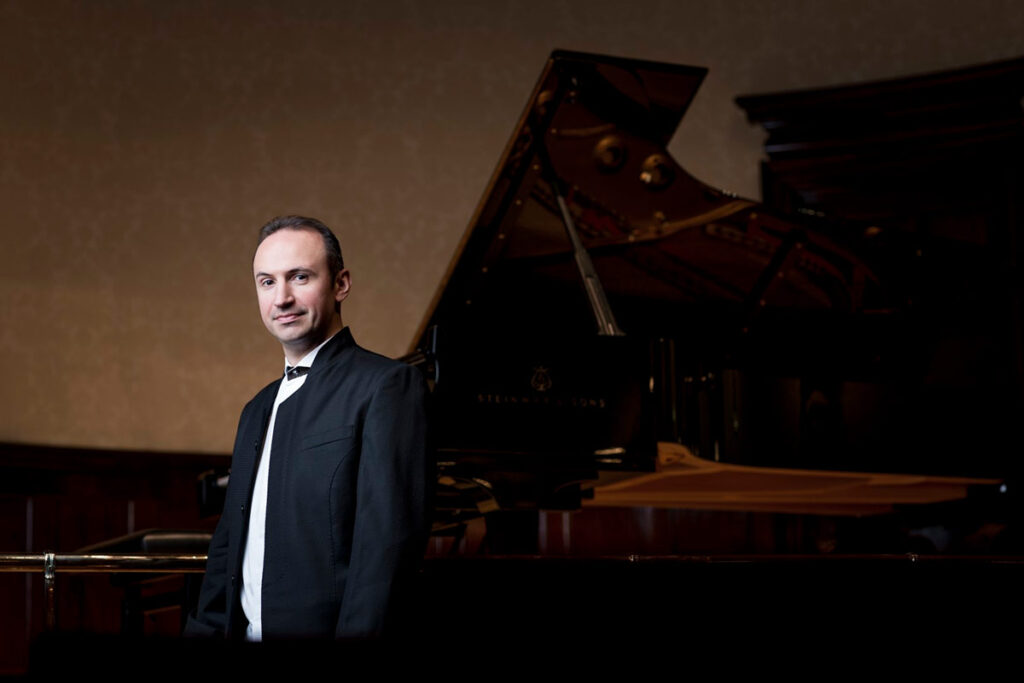Four Mazurkas, Op. 24 Frédéric Chopin
(1810-1849)
No. 1 in G Minor
No. 2 in C Major
No. 3 in A-flat Major
No. 4 in B-flat Minor
Before leaving his beloved Poland, Chopin spent time in the country around Warsaw. There, he listened to folk music, particularly dances called mazurkas. Eventually, between 1830 and 1849, he composed nearly 60 mazurkas for solo piano. By writing in this form Chopin was able to keep his love for Poland alive. When he left his homeland, his teacher Joseph Elsner, gave him an urn filled with Polish soil which Chopin kept always. Most of him was buried with it in Père Lachaise Cemetery in Paris. His heart, however, was smuggled from Paris to Warsaw by his sister (literally hidden under her skirt) where it resides today at Holy Cross Church. (For a hair-raising, or perhaps heart-stopping history of Chopin’s heart, read the Wikipedia entry, or the Nature magazine article.) The pathological fear of being buried alive, taphephobia, was an obsession in the 19th century. Some coffins even had alarms that could be activated from within. Chopin suffered from this fear (as did George Washington, Alfred Nobel, Hans Christian Anderson, Auguste Renoir and others), hence his last recorded words: “Swear to make them cut me open, so that I won’t be buried alive.”
Chopin is often credited with writing the earliest piano mazurkas, but that honor actually belongs to another Pole, Maria Szymanowska (1789-1831). She was one of the first professional virtuoso pianists of the 19th century to tour Europe. Maria gave her first public recital in Paris in 1810, the year Chopin was born. It’s not clear whether she ever met Chopin in person, but her influences on him both as a pianist and a composer are clear. All of her favorite genres – mazurkas, waltzes, polonaises, preludes, and etudes – were later represented in Chopin’s works.
Op. 24 was composed in 1834-35, just a few years after Chopin emigrated to Paris, and were dedicated to Conte de Perthius, music director for Louis Philippe of France. Rhythmically and harmonically diverse, each with a different tempo marking, they don’t represent a set “recipe” of any kind. Even so, they are in ABA form, meaning that the opening material comes back after a contrasting middle section. They are compelling examples of Chopin’s ability to use internal repetition in powerful ways, never suggesting that he is simply saying the same thing.
Soon after he settled in Paris, Chopin’s Op 2 Variations on Mozart’s “Là ci darem la mano” for orchestra and piano were glowingly reviewed by Robert Schumann: “Hats off gentlemen! A genius!”
Variations on “Come un agnello,” K. 460 Wolfgang A. Mozart
(1756-1791)
The original manuscript for this piece, a theme and eight variations, includes only the theme and two variations in Mozart’s hand. Scholars love to have dustups over this kind of discovery, so there has been a serious ongoing controversy over whether Mozart wrote the remainder of the variations, or if Giuseppe Sarti actually completed the work. This argument went on literally for decades, as these things do, possibly resulting in several MMs and DMAs. Today scholars generally agree that they are a combined effort, where Mozart improvised the remaining variations and Sarti transcribed them to paper. This is a credible possibility since Mozart loved to display his virtuosity by improvising on the spot in performances. For some this might cause nervous conniption, but not for Mozart. At the première of his Prague Symphony in 1787, he improvised a 30-minute encore with twelve variations based on his own aria, “Non Piu Andrai” from The Marriage of Figaro.
“Come un agnello” (like a lamb) is an aria from a comic opera written in 1782 by Sarti. Mozart had written to his father: “Sarti is a good honest fellow! I have played a great deal to him and have composed variations on an air of his, which pleased him exceedingly.” The aria was popular enough in its day that Mozart quoted it three years later in Don Giovanni. It is used in the finale of Act II as incidental music during the Don’s supper. Leporello, the valet, announces it right after Mozart quotes his own “Non piu andrai”. (One might safely assume that Mozart really liked his aria!)
So, was this work written by Mozart’s hand or Sarti’s? Let’s go with the scholars on this, and simply figure it gives us insight into Mozart’s incredible improvisatory abilities, brought to us now by today’s performer.
Selections from “The Nutcracker” Piotr I.Tchaikovsky / arr. M. Pletnev
(1840-1893; arr.1978)
- March
- Dance of the Sugar Plum Fairy
- Tarantella
- Intermezzo
- Trepak – Russian Dance
- Chinese Dance
- Andante Maestoso
It may seem early for Christmas music, but we all know that shopping will begin right after Easter, so sit back and enjoy these beloved ballet treasures. The Nutcracker contains the first use of the newly invented bell-like instrument, the celesta, featured in the “Dance of the Sugar Plum Fairy” (also the predominant instrument in “Hedwig’s Theme” from Harry Potter). Tchaikovsky smuggled the new instrument into Russia from Paris. It is unclear whether it was illegal to take it out of France or into Russia. Tchaikovsky himself was a harsh critic of his work. He claimed that “in spite of all the sumptuousness it did turn out to be rather boring”. The world ever since has disagreed.
The arranger, Mikhail Vasilievich Pletnev, is a Russian pianist, conductor, and composer, currently living in Switzerland. Gold Medalist and First Prize winner at the 1978 Tchaikovsky International Piano Competition at 21, he played his own transcription of the Nutcracker, a stunning move for a lad barely out of short pants. In the footage he looks every bit that young! His prizes gave him international recognition, and in 1988 he was invited by President Mikhail Gorbachev to perform at the superpower summit in Washington.
Writing this transcription was not easy for Pletnev, nor is it an easy performance for Trpčeski. This transcription replaces a full orchestra of 55-62 players with the ten fingers of one man. It requires a very broad range of piano technique, with numerous touch types, demanding masterful control, and a complete fearlessness. It is incredible to hear such a feat, no matter what time of year!
Note: If you haven’t listened to the Rachmaninoff 2nd piano concerto on the Corvallis Piano International website, do yourself a favor. It’s a pairing of Pletnev on the podium and Trpčeski at the piano.
Today’s performance features two sets of variations by Beethoven, of the 20 he wrote. The standard way to catalog one’s compositions was by using opus numbers when they were published. WoO simply means “without an opus number”. WoO WoO!!
Twelve Variations on a Russian Dance, WoO 71 Ludwig van Beethoven
(1770-1827)
We generally don’t think of Beethoven on a horse, well, I don’t anyway. But the woman to whom this set of variations is dedicated, Countess von Browne, was so moved by his gesture she gave him a horse. He apparently rode it a few times, but there is no evidence that the young composer was happy with this acquisition and apparently soon forgot about it, and mostly so has history. A stable hand where he kept the horse actually started renting it out.
The theme for this set of twelve variations from 1797 was from a ballet by the Czech composer Paul Wranitzky, who had emigrated to Vienna. Beethoven’s composition displays drama and restlessness, with some very serious, some playful, and some very fiery variations. It will be apparent to you that Beethoven’s approach in variation form is quite different from Mozart’s. The theme becomes more obscured and the range of the piano greater. The use of rhythm is more complex and more changeable. Beethoven’s life paralleled the evolution of the piano, and the development of the instrument itself, with increasing octaves, simply gave composers more to work with. A fine technique is required. Beethoven’s virtuosity, while plentiful, is only used in the service of a musical idea but never for its own sake.
Thirty-two Variations on an Original Theme in C Minor, WoO 80
Written ten years later, this set of variations was entirely based on 8 bars of music which Beethoven wrote. He did not assign this work an opus number, and apparently had some contempt for it. “We are told that he once found a young lady practicing it, and after listening awhile asked: ‘By whom is that?’ ‘By you’ she returned wonderingly. ‘Such nonsense by me? O Beethoven, what an ass you were!’ (Hutcheson/Ganz). History does not support his disparagement of the piece, and it remains the most widely performed set of Beethoven’s variations. Only 8 bars led to all this creativity!
Sonata No. 7 in B-flat Major, Op. 83 Sergei Prokofiev
(1891-1953)
This is the most frequently performed sonata of the nine Prokofiev composed. Written in 1942, it is one of the three “War Sonatas”. Premiered in 1943 in Moscow, Sviatoslav Richter had just four days to learn and memorize the piece. Heinrich Neuhaus, Richter’s teacher at the Moscow Conservatory, allowed Richter to learn it on his piano, under which Richter slept when he had nowhere else to live (doesn’t that make you like Neuhaus straightaway?). Depicting the horrors of war, the sonata is brutal and harsh, angular and disjointed. Richter wrote: “With this work, we are brutally plunged into the anxiously threatening atmosphere of a world that has lost its balance. Chaos and uncertainty reign. We see murderous forces unleashed. But this does not mean that what we lived by before thereby ceases to exist. We continue to feel and to love. Now the full range of human emotions bursts forth. In the tremendous struggle that this involves, we find the strength to affirm the irrepressible life-force.” His words truly capture the piece.
Allegro inquieto, as the words suggest, is nervous and unsettled, filled with chromaticism, leading to a tumultuous conclusion. Andante caloroso (warmly) is a lyrical and complex movement, very rich in its harmonic language. It is based on Robert Schumann’s lied, “Wehmut”, whose text begins “I can sometimes sing as if I were glad, yet secretly tears well and so free my heart.” It becomes less comforting as it unfolds, but the lyricism returns to end the movement. Precipitato is a frightening, breathtaking toccata, a tornado which will touch down in our midst. The percussive nature of the piano is predominant, living up to Prokofiev’s belief that the piano is percussive and should be played that way! Hold on to your hats, but don’t cover your ears!
© Diane Baxter, 2024



